MB-800 : Microsoft Dynamics 365 Business Central Functional Consultant : Part 03
MB-800 : Microsoft Dynamics 365 Business Central Functional Consultant : Part 03
-
You are implementing Dynamics 365 Business Central. You create items for infinite items such as water, electricity, and natural gas that are used in manufacturing processes.
You need to set up the items.
Which item type should you use for infinite items?
- Resource
- Inventory
- Service
- Non-Inventory
-
A company uses Dynamics 365 Business Central.
A customer requests that the company always use their preferred shipping provider for all sales orders.
You need to configure the system to meet this requirement.
What should you do?
- Select Shipping Advice
- Define a shipping agent
- Set up a Ship-to code
- Designate a Responsibility center
-
You are implementing Dynamics 365 Business Central for a customer.
The customer wants to manually add many similar items.
You need to help the customer create copies of existing items.
Which three actions must be performed? Each correct answer presents part of the solution.
NOTE: Each correct selection is worth one point.
- On the Set up Customer/Vendor/Item Templates page, create a new item template
- Open an existing item, and then click the Save as Template action on the item card
- On the Set Up Customer/Vendor/Item Templates page, edit the information in the newly created item template
- On the Configuration Templates page, create a new template for item table
- Create a new item, and then select the new template name to copy the information to the item
-
DRAG DROP
You are configuring Dynamics 365 Business Central for a company.
You need to create items.
Which item types should you use? To answer, drag the appropriate item types to the correct scenarios. Each item type may be used once, more than once, or not at all. You may need to drag the split bar between panes or scroll to view content.
NOTE: Each correct selection is worth one point.

MB-800 Microsoft Dynamics 365 Business Central Functional Consultant Part 03 Q04 031 Question 
MB-800 Microsoft Dynamics 365 Business Central Functional Consultant Part 03 Q04 031 Answer -
You are implementing Dynamics 365 Business Central Online.
You receive a comprehensive price list from the customer. The customer wants you to set up the best price feature for sales by using the standard discount and pricing functionality in Business Central.
You need to set up this feature.
Which three components are part of the best price calculation feature? Each correct answer presents a complete solution.
NOTE: Each correct selection is worth one point.
- Unit cost on items
- Sales Line Discounts
- Vendor Discount Groups
- Special Prices
- Unit prices on items
-
You are setting up a new company for a customer.
The customer wants to sell items in boxes and pallets, but refer to the items as pieces. Each box contains 12 pieces. Each pallet contains 144 pieces.
You need to assign the unit of measures to items.
How should you assign the unit of measures?
- Create Box as a base unit of measure. Add Pieces as an item unit of measure with the quantity per unit set to 0.08333.
- Create Pallet as a base unit of measure. Add Pieces as an item unit of measure with the quantity per unit set to 0.0069.
- Create Pieces as a base unit of measure. Add Pallet as an item unit of measure with the quantity per unit set to 144.
- Create Pallet as a base unit of measure. Add Box as an item unit of measure with the quantity per unit set to 0.08333.
-
HOTSPOT
A company uses Dynamics 365 Business Central.
A vendor needs to use a default warehouse location and invoice a different vendor for a purchase order.
You need to configure the system to meet the requirements.
Which controls should you use? To answer, select the appropriate options in the answer area.
NOTE: Each correct selection is worth one point.

MB-800 Microsoft Dynamics 365 Business Central Functional Consultant Part 03 Q07 032 Question 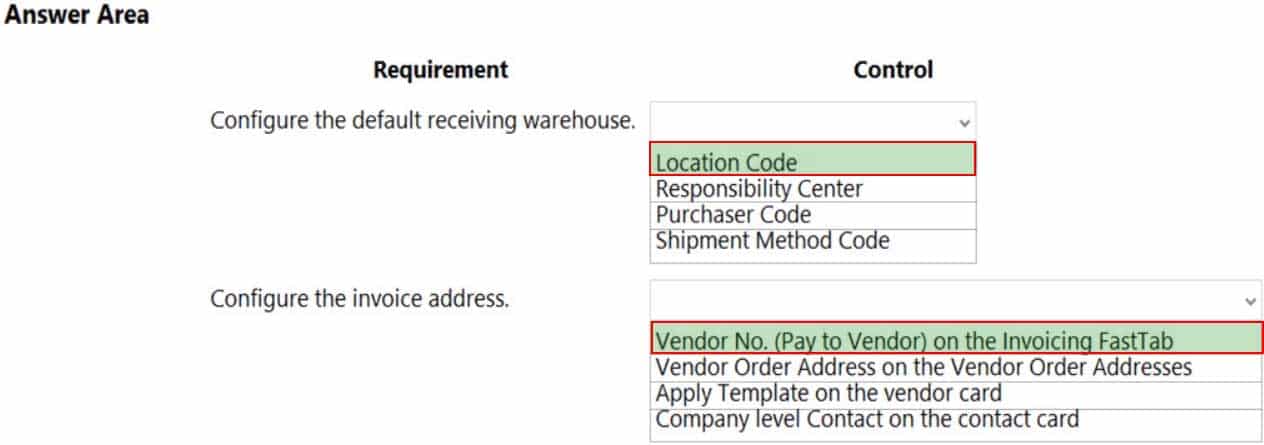
MB-800 Microsoft Dynamics 365 Business Central Functional Consultant Part 03 Q07 032 Answer -
DRAG DROP
You set up a sales module for a company. The manager provides you with the company sales price list.
The correct net price for products must display when the sales team creates sales orders.
You need to configure the system.
Which setup types should you use? To answer, drag the appropriate setup types to the correct scenarios. Each setup type may be used once, more than once, or not at all. You may need to drag the split bar between panes or scroll to view content.
NOTE: Each correct selection is worth one point.

MB-800 Microsoft Dynamics 365 Business Central Functional Consultant Part 03 Q08 033 Question 
MB-800 Microsoft Dynamics 365 Business Central Functional Consultant Part 03 Q08 033 Answer -
DRAG DROP
You are setting up a new company for a customer.
The customer wants to understand the structure of the elements involved in inventory posting.
You need to describe the relationship between elements in a basic inventory setup.
What is the hierarchical order of the elements included in inventory posting beginning with the master data? To answer, move the appropriate three entities from the list of actions to the answer area and arrange them in the correct order.
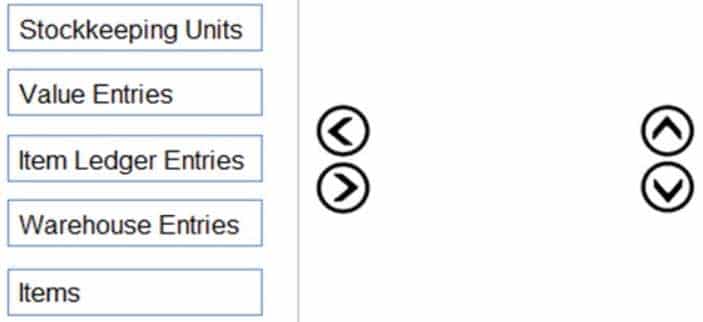
MB-800 Microsoft Dynamics 365 Business Central Functional Consultant Part 03 Q09 034 Question 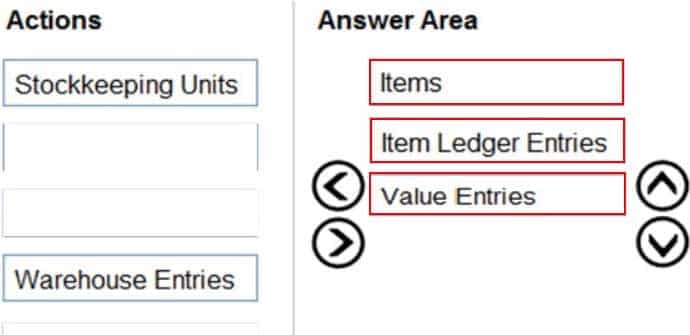
MB-800 Microsoft Dynamics 365 Business Central Functional Consultant Part 03 Q09 034 Answer -
HOTSPOT
You create a new item in Microsoft Dynamics 365 Business Central.
You need to configure item settings.
Which item settings should you use? To answer, select the appropriate options in the answer area.
NOTE: Each correct selection is worth one point.

MB-800 Microsoft Dynamics 365 Business Central Functional Consultant Part 03 Q10 035 Question 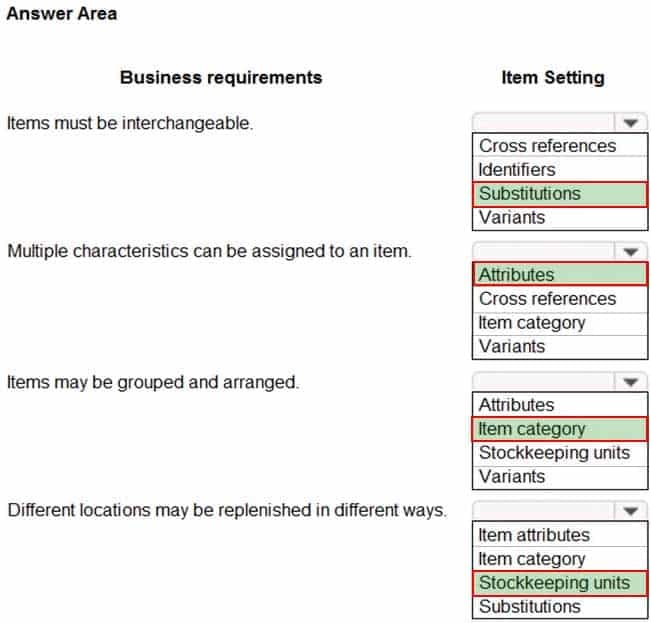
MB-800 Microsoft Dynamics 365 Business Central Functional Consultant Part 03 Q10 035 Answer -
DRAG DROP
You are setting up a new item in Dynamics 365 Business Central. The item is a tangible good with an inventory asset value. The item is acquired by purchase specifically for each new instance of demand from an order.
You need to configure the Type, Replenishment System, and Reordering Policy fields on the item card to achieve the stated requirements.
How should you configure each field? To answer, drag the appropriate values to the correct fields. Each value may be used once, more than once, or not at all. You may need to drag the split bar between panes or scroll to view content.
NOTE: Each correct selection is worth one point.

MB-800 Microsoft Dynamics 365 Business Central Functional Consultant Part 03 Q11 036 Question 
MB-800 Microsoft Dynamics 365 Business Central Functional Consultant Part 03 Q11 036 Answer -
A company uses Dynamics 365 Business Central.
A customer wants to sell items that are not normally counted in the company’s warehouse.
You need to configure the system to meet this requirement.
What should you set up?
- Non-Inventory Item type
- Item charge
- Inventory Item type
- Resource
- This is a case study. Case studies are not timed separately. You can use as much exam time as you would like to complete each case. However, there may be additional case studies and sections on this exam. You must manage your time to ensure that you are able to complete all questions included on this exam in the time provided.
To answer the questions included in a case study, you will need to reference information that is provided in the case study. Case studies might contain exhibits and other resources that provide more information about the scenario that is described in the case study. Each question is independent of the other questions in this case study.
At the end of this case study, a review screen will appear. This screen allows you to review your answers and to make changes before you move to the next section of the exam. After you begin a new section, you cannot return to this section.
To start the case study
To display the first question in the case study, click the Next button. Use the buttons in the left pane to explore the content of the case study before you answer the questions. Clicking these buttons displays information such as business requirements, existing environment, and problem statements. When you are ready to answer a question, click the Question button to return to the question.
Background
Wide World Importers is a family-owned importer of specialty cooking ingredients and prepackaged foods from the Mediterranean. When first established, the company’s products were sold at farmers markets, All sales were on a cash-only basis.
Products are now sold locally to restaurant owners and chefs in a family-owned building with a warehouse. Products are no longer sold at farmers markets. Cash and carry sales generate most of the revenue for the company.
The founder of Wide World Importers is turning over control of the company to the younger generation in the family. These family members want to use Dynamics 365 Business Central to support their efforts to grow and diversify the business. They recently started to build a new line of business selling and shipping products to specialty retailers outside their local area through a network of brokers and representatives.
The company uses QuickBooks, but the family is concerned that QuickBooks is not capable of supporting their new business model.
There are 30 full-time and part-time employees who work in sales, purchasing, shipping, customer service, accounts payable, accounts receivable, and finance. The family does not plan to hire additional personnel to support the new line of business.
Current environment
Cash and carry sales
– When a customer makes a purchase at the company’s cash and carry desk, the sale is handwritten on a three-part form.
– The cash and carry associate retrieves the items listed on the order from the warehouse.
– Special prices and discounts are used to move products that will expire soon or that are overstocked.
– Cash is accepted for payments.
– The cash drawer is balanced at the end of every day. A deposit is created for the cash and given to the accountant.
– One-line sales invoices are saved in QuickBooks for each cash and carry sale to a miscellaneous customer.
– Customer details for cash and carry sales are not kept in QuickBooks.Brokered sales orders
– Brokered sales are called in to customer service by the brokers and sometimes directly by customers. The sales are entered into QuickBooks.
– Because inventory is not tracked in QuickBooks, the generic item Brokered Item is used.
– Two copies of the packing slip and printed from QuickBooks and sent to the warehouse.Order picking
– The warehouse manager provides a container and the two copies of the packing slip to a picker.
– Items that are out of stock are marked on both copies of the packing slip.
– The shipping amount is determined and written on the packing slips.
– One copy of the completed packing slip is placed in a basket for customer service.
– Completed orders are boxed up with a copy of the invoice and shipped to customers.Order invoicing
– Throughout the day, the customer service manager collects the packing slip copies and updates the invoices in QuickBooks.
– The customer service manager adds a line for shipping with the amount provided by the packer.
– The customer service manager prints a copy of the final invoice and sends it to the warehouse.
– The accountant uses Microsoft Word to create weekly invoices for all shipments invoiced in QuickBooks during the week for some customers.Deposits
– The accountant receives the deposit bag from the cash and carry sales desk at the end of every day.
– Receipts are recorded in QuickBooks against cash and carry and brokered sales based on the deposit slips.Brokers commission
– Brokers fees are paid as a percentage of sales.
– A Sales by Product/Service Summary report is run in QuickBooks every month for Brokered Item to calculate what is owned.Requirements
Customers
– Users with permission must be able to quickly add new customers.
– The original source of all customers in the accounting system must be identified to be from cash and carry or brokered sales.
– The company needs to keep a record of special price promotions given to specific customers.
– Customers must be identified with a unique general business posting group so that the correct freight G/L account is used in sales transactions.Sales
– The customer source must be used to identify the business line, and the customer source must be indicated on every sales transactions.
– Customer service and cash and carry desk associates must be able to enter sales into Dynamics 365 Business Central by customer.
– Excess paper must be eliminated, and paper management must be reduced.
– If a customer is not already listed in the system, a cash and carry associate or customer service associate must be able to quickly add the new customer in the process of recording the first sale.
– A point-of-sale system is not needed, but users must be able to record which items are purchased by customers, accept and record their payment, and print receipts indicating paid in full.Items
– The sales manager and warehouse manager must be able to set a specific timeframe for special promotion discounts on items.
– For special promotions, discounts must be consistent for all items in a product line using a single discount calculation.
– Special pricing may be given to a retail chain or buying group. This pricing must be automatically applied when an order is taken for any of these customers. The original price must be recorded with each sale.
– Customers must always be charged the lowest amount for an item at the time of the sale. For example, an overstocked olive oil has a regular price of $20 per unit. Customers in a buying group for restaurants can buy it for $18 per unit. There is an autumn promotion price for the item at $19 per unit. However, on a specific day only, there is an overstock special at a 15 percent discount off the regular price.Sales invoices
– Warehouse workers must be able to indicate the following in the system for each order:
1. the items picked
2. the shipping charges
3. notifications, if any, that customer service needs to provide to the customer
– Items sold at a discount must show the original price, discount, and net amount on each line of the invoice. Invoices must be posted at the cash and carry desk at the time of sale. For orders, accounting must post invoices and send them to customers.
– Warehouse employees must be able to indicate what has been shipped on an order. They will use the G/L account for shipping charges. They need to use the correct G/L account for sales versus cost through proper assignment of sales and purchase accounts in the general posting setup.
– Some of the brokered customers require one invoice per week regardless of the number of orders or shipments.Accounts
– Payment terms vary by customer.
– The amount paid to brokers must be calculated from sales after invoice discounts.
– Broker vendors must be easily identifiable from other vendors in lists
– Commission paid on sales not collected within 120 days must be deducted from brokers’ next compensation payment.Reporting
Wide World Importers requires reporting on the following:
– the overall profitability of each line of business at any time for any given period
– the cost of outbound shipping in the overall profitability of sales by business line in all related reports
– freight sales and cost by account in the trial balance
– the cost of brokers’ compensation in reporting the overall profitability of sales by business line
– the effect of item discount promotions in financial statements.Issues
Pricing
– Spreadsheets are used to maintain special item pricing and discounts. The only source of product line discount information is a whiteboard in the warehouse. The price charged is frequently incorrect.
– Customers complain when they think they think they have not received the best price available. Promotions are sometimes applied in error after a special pricing event ends, for example, when discounts are offered temporarily to reduce overstock.
– Management cannot see original versus actual price on all sales. Discounts given by brokers requires spreadsheets and comparison between price list and price on sales invoice. Management needs to be able to quickly see the discount given on each sale.Payment terms
– Agreed-upon payment terms are frequently entered incorrectly on orders, causing cashflow issues.
– Invoices already paid in full exist on the sales aging reports. The frequent cause of this issue is that sales from the cash and carry desk are not indicated as cash sales and are not posted as paid in full.
– Some buying groups require that all invoices sent during a month be due on the 20th of the following month.Invoicing
– Paperwork is frequently misplaced between the warehouse, customer service, and accounting.
– Invoices that are posted in the accounting system based on shipments and invoices that are sent to customers weekly do not match due to errors transferring the data from one document to another.
– Users are selecting the incorrect freight type (expense versus sales) on purchase and sales transactions, making it difficult to reconcile freight costs.
– Sales placed from the cash and carry desk by customers originally acquired through a broker are not being recognized with the correct customer source. Reporting by business line is inaccurate.Accounts
– Users often forget which fields to use to enter information when they add new customers to QuickBooks. This results in errors and inconsistencies in data and affects sales reporting. Confidence in sales reporting accuracy is low.
– Adding new brokers is a different process than adding other purchase vendors. Users often forget which fields to select and how to correctly assign the vendor number to add new brokers.
– Manual entries to certain G/L accounts cause reconciliation issues.-
DRAG DROP
You need to configure discounting for sales.
Which three actions should you perform in sequence? To answer, move the appropriate actions from the list of actions to the answer area.
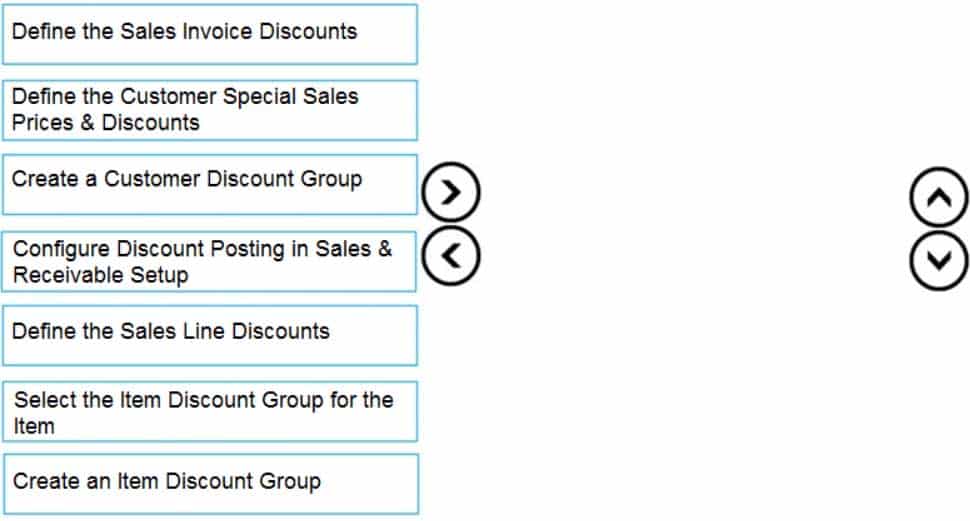
MB-800 Microsoft Dynamics 365 Business Central Functional Consultant Part 03 Q13 037 Question 
MB-800 Microsoft Dynamics 365 Business Central Functional Consultant Part 03 Q13 037 Answer -
A customer in the restaurant buying group purchases olive oil on the date of the overstock special.
You need to verify the sales price of the product for the customer.
Which price will the system generate?
- $15.30
- $16.15
- $17.00
- $18.00
Explanation:An overstocked olive oil has a regular price of $20 per unit.
However, on a specific day only, there is an overstock special at a 15 percent discount off the regular price.The 15% is deducted from the ‘regular’ price ($20), not the special price that the restaurant buying group pay ($18).
-
- This is a case study. Case studies are not timed separately. You can use as much exam time as you would like to complete each case. However, there may be additional case studies and sections on this exam. You must manage your time to ensure that you are able to complete all questions included on this exam in the time provided.
To answer the questions included in a case study, you will need to reference information that is provided in the case study. Case studies might contain exhibits and other resources that provide more information about the scenario that is described in the case study. Each question is independent of the other questions in this case study.
At the end of this case study, a review screen will appear. This screen allows you to review your answers and to make changes before you move to the next section of the exam. After you begin a new section, you cannot return to this section.
To start the case study
To display the first question in the case study, click the Next button. Use the buttons in the left pane to explore the content of the case study before you answer the questions. Clicking these buttons displays information such as business requirements, existing environment, and problem statements. When you are ready to answer a question, click the Question button to return to the question.Background
Best for You Organics Company is a mid-sized wholesale distributor of organic produce and other food items to national retail grocery store chains. Over half the company’s revenue is from produce with an average shelf life of less than a week. The remaining revenue comes from shelf-stable canned and packaged items.
Best for You Organics experienced substantial growth in the last two years. They expanded from one location to three locations, increased the number of employees from 25 to over 100, and more than doubled their revenue. The company’s business forecast predicts a steady rate of growth of at least 20 percent annually for the next five years.
As a result of their expansion, Best for You Organics is experiencing delays and bottlenecks in their processes. The company has decided to implement Dynamics 365 Business Central as a new Enterprise Resource Planning (ERP) solution to increase efficiency and automation to support their continued growth.
Current environment
Deliveries
– The company receives daily truckloads of products from their vendors, warehouses the products briefly, and then ships orders based on a weekly delivery cycle to each customer’s store.
– Customers have regular standing orders that are revised and finished one week prior to delivery.
– Best for You Organics has a fleet of trucks that make deliveries according to planned routes.
– The company also has a floating route for trucks to deliver rush orders. The route is being used more often by customers and has overwhelmed the warehouse with exception processing.Duties
The company wants to provide greater separation of duties between activities in the office and activities in the warehouse.
The accounting team enters orders for the sales team, sends pick tickets back to the warehouse, and organizes shipping documents. The accounting team invoices the orders when they receive instructions from the warehouse that an order shipped.
Employees have expressed frustration because they need to work longer hours to accommodate the increase in sales.
The company does not use the Advanced Warehousing function.
Requirements
Salespeople
– Salespeople must be able to manage opportunities that are converted to quotes.
– Salespeople must be able to release orders to the warehouse to be fulfilled once a quote is final.
– Salespeople must be trained on how to determine if inventory is available when they are completing the quote to avoid promising inventory that is not on hand because all orders are processed one week in advance of delivery.Team responsibilities
Deliveries must be shipped daily by employees in the warehouse. The office must be responsible for completing the invoicing process.
The current team responsibilities are shown in the following graphic:

MB-800 Microsoft Dynamics 365 Business Central Functional Consultant Part 03 Q14 038 The required team responsibilities are shown in the following graphic:
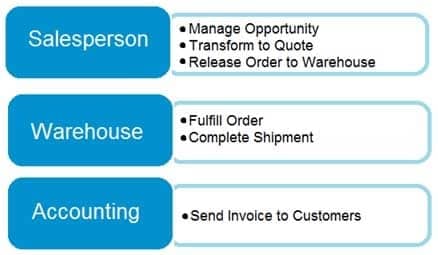
MB-800 Microsoft Dynamics 365 Business Central Functional Consultant Part 03 Q14 039 Vendor management
– The company contracts with each vendor for regular discounts at the invoice level.
– The company requires a pre-set discount percentage to calculate automatically when the purchaser completes a purchase order.
– The company must be able to see a copy of the completed purchase order in the system when they have new contract negotiations with their vendors.Customer and inventory management
– Sales invoices must be automatically emailed by the system to customers.
– A template must be used for emails sent to customers. The template must not be altered.
– Customers who pre-pay their invoices must not receive a copy of their invoices.
– The company warehouses all products as Case quantities. The company has difficulty recording accurate costs for product returns. The company wants to expand their capabilities for managing returns by setting up all inventory in a quantity of Each.Reporting
The company must be able to answer two key questions when they report financial results:
– Which customers are buying which items?
– Which salespeople are selling in which regions?When discussing customers, the company must refer to each Customer Group as follows:
– Big Box
– Franchise
– PrivateWhen discussing items, the company must refer to each Item Group as follows:
– Fair Trade
– Free Range
– Grass Fed
– Heirloom
– OrganicSalesperson names that must be used are:
– Salesperson A
– Salesperson B
– Salesperson C
– Salesperson DRegion names that must be used are:
– North
– South
– East
– WestCommission
– The company must be able to track salesperson performance within certain regions to calculate commission.
– Each salesperson must be assigned only to a single region.
– This commission data is currently recorded inconsistently, resulting in incorrect combinations that require manual correction. The company must have some level of automation to manage this.Issues
Issue 1
The accounting team needs an improved process for reconciling inventory to the general ledger.
– Posted transactions are changing financial reporting in periods that have been closed.
– Unexpected changes in inventory cost for previous months are causing costing inaccuracies.
– The system must restrict the adjustment of costs for closed months.
– The new policy will be to restrict all users to posting in the current month only, with the exception of a few employees from the accounting team.
– The calendar fiscal year for company must begin on June 1.Issue 2
The accounting team uses a complex manual accrual process to determine the accounting impact of items received but not invoiced. The system must streamline the item accrual process.
Issue 3
The company often receives a higher quantity of produce items than what they order because vendors allow for spoilage or damage of produce in transit. The company does not want to allow over receipt on non-produce items.
Issue 4
The company has received comments from their auditors that invoices are not being properly compared to received inventory documents before they are posted. The company does not use warehouse management and always handles processes directly from the purchase order. The company always has the following documents:
– purchase order from the procurement department
– receiving document from the warehouse
– electronic invoice from the vendor-
You need to set up units of measure for an item to meet the requirements.
What are two possible ways to achieve the goal? Each correct answer presents a complete solution.
NOTE: Each correct selection is worth one point.
- Set a Unit of Measure for case to a Qty. of 10.
- Set a Qty. per Unit of Measure to 1 in the Item Units of Measure table.
- Set a Unit of Measure for case to a Qty. of 1.
- Add a Code and Description to the Units of Measure table.
-
-
DRAG DROP
You complete Payment Registration setup. The following options are enabled:
– Use this account as default
– Auto Fill Date receivedYou need to process a single full payment from a customer against the amounts due for two invoices by using customer payment registration.
What four actions should you perform in sequence? To answer, move the appropriate actions from the list of actions to the answer area and arrange them in the correct order.
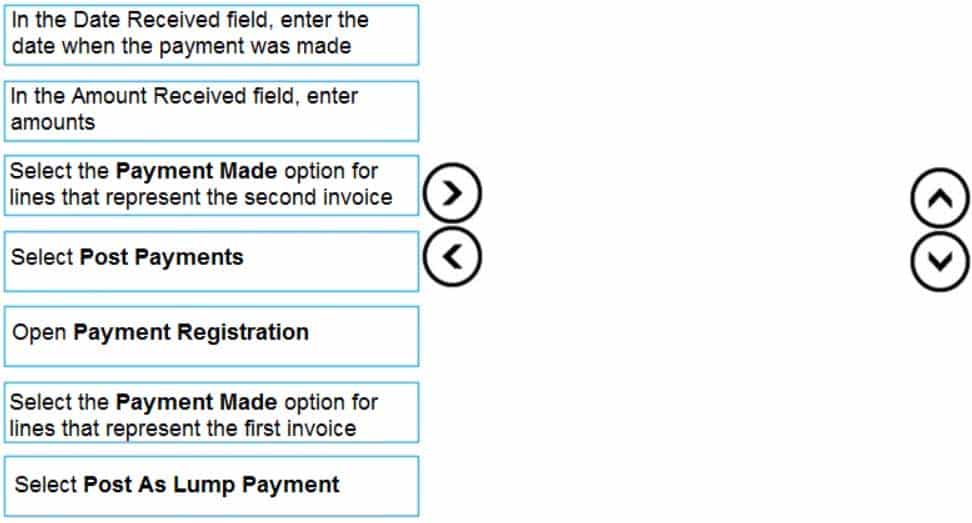
MB-800 Microsoft Dynamics 365 Business Central Functional Consultant Part 03 Q15 040 Question 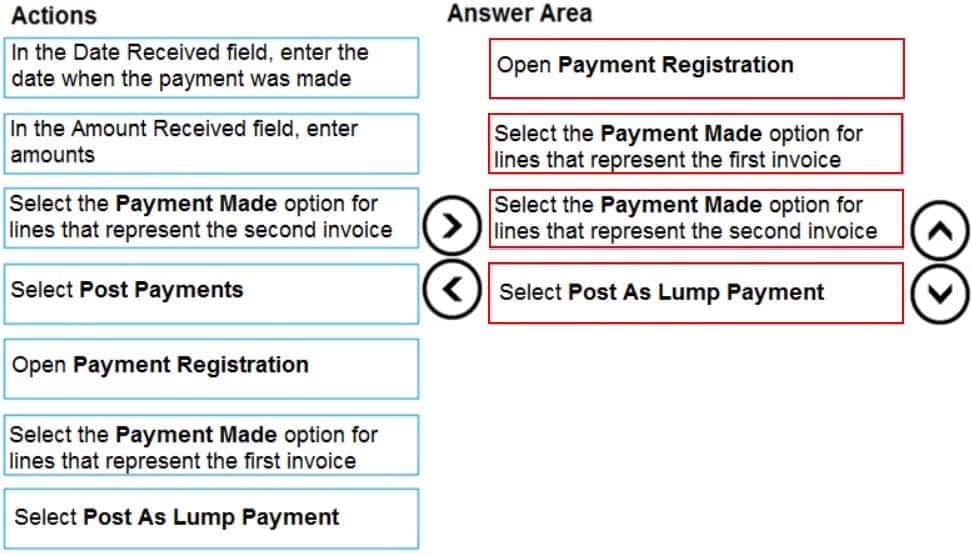
MB-800 Microsoft Dynamics 365 Business Central Functional Consultant Part 03 Q15 040 Answer -
You need to configure Dynamics 365 Business Central to allow for receipt of quantities of items greater than the quantity ordered.
What are two possible ways to achieve the goal? Each correct answer presents a complete solution.
NOTE: Each correct selection is worth one point.
- Configure a maximum order quantity for the item
- Configure a maximum inventory level for the item
- Set up and select an over-receipt code in the item record
- Set up and select an over-receipt code in the vendor record
-
DRAG DROP
You have multiple, unpaid posted purchase invoices to reverse. Some invoices require complete reversal while others need partial reversal.
You need to process credit memos from the posted purchase invoices page.
Which actions should you perform? To answer, drag the appropriate action buttons to the correct requirements. Each action button may be used once, more than once, or not at all. You may need to drag the split bar between panes or scroll to view content.
NOTE: Each correct selection is worth one point.

MB-800 Microsoft Dynamics 365 Business Central Functional Consultant Part 03 Q17 041 Question 
MB-800 Microsoft Dynamics 365 Business Central Functional Consultant Part 03 Q17 041 Answer -
DRAG DROP
A company uses Dynamics 365 Business Central.
The company’s funds are limited and some invoices that are due cannot be paid on time.
You need to prioritize vendors when you suggest vendor payments.
Which three actions should you perform in sequence? To answer, move the appropriate actions from the list of actions to the answer area and arrange them in the correct order.
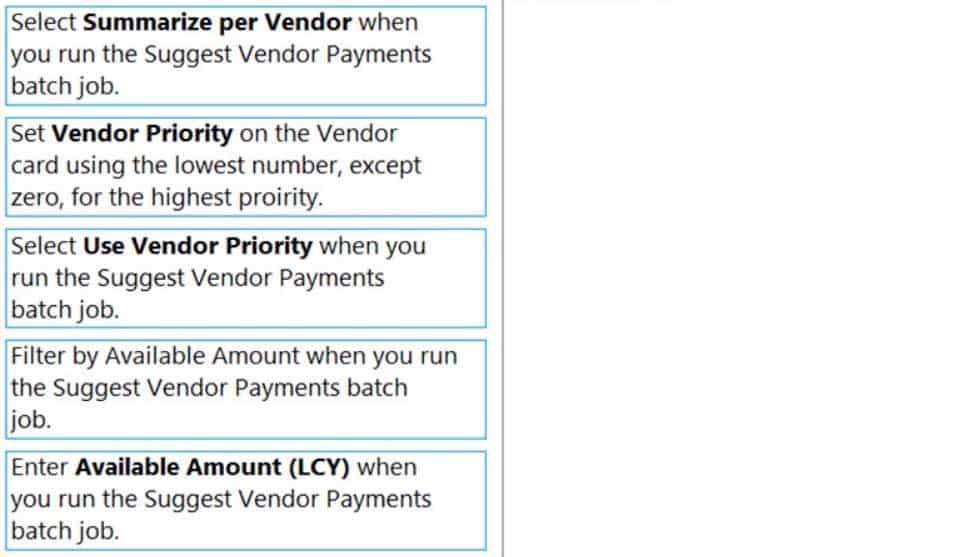
MB-800 Microsoft Dynamics 365 Business Central Functional Consultant Part 03 Q18 042 Question 
MB-800 Microsoft Dynamics 365 Business Central Functional Consultant Part 03 Q18 042 Answer -
You have a Microsoft Excel file that includes journal entry data that must be imported into Dynamics 365 Business Central. This file was previously imported into a General Journal batch.
You receive an updated version of the file that includes corrections, deletions, and new journal entries.
Which two actions can you perform by using the Edit in Excel feature? Each correct answer presents a complete solution.
NOTE: Each correct selection is worth one point.
- Modify an existing line in a General Journal batch
- Insert a new line in a General Journal batch
- Post one or more lines in a General Journal batch
- Request Approval for one or more lines in a General Journal batch
- Delete an existing line from a General Journal batch
-
A user reports that they cannot create or view sales quotes in Dynamics 365 Business Central.
You need to help the user create and view sales quotes.
From which three cards can the user perform the required activities? Each correct answer presents a complete solution.
NOTE: Each correct selection is worth one point.
- Service Item
- Opportunity
- Job
- Resource
- Customer
- Contact